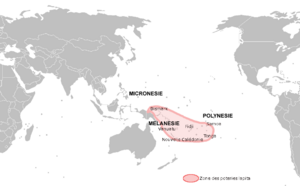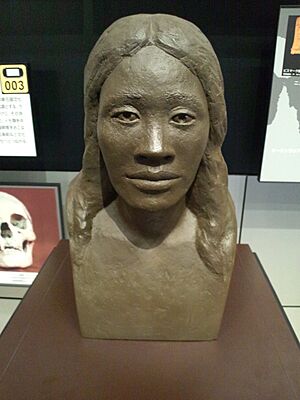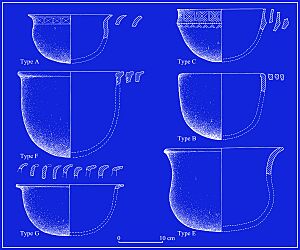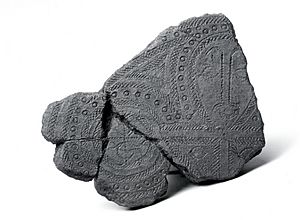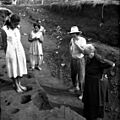Lapita culture facts for kids
The Lapita culture was a group of ancient people who lived in the Pacific Ocean around 1600 to 500 BCE. They were part of the Austronesian peoples and are known for their special pottery with unique designs. These people traveled across the sea and settled in places like Island Melanesia.
Scientists believe the Lapita people originally came from the northern Philippines. They might have traveled through the Mariana Islands or directly from the Philippines, or both ways. Their pottery designs look very similar to ancient pottery found in the northern Philippines. The Lapita people mixed with local Papuans and are the direct ancestors of many people living in Polynesia, eastern Micronesia, and Island Melanesia today.
Contents
- What Does "Lapita" Mean?
- When Did the Lapita Culture Thrive?
- What Kind of Things Did Lapita People Make?
- How Did Lapita People Live?
- What Were Lapita Burial Customs Like?
- Where Did Lapita People Settle?
- Where Was the Lapita Culture Found?
- What Language Did Lapita People Speak?
- Where Did the Lapita People Come From?
- How Was the Lapita Culture Discovered?
- Lapita in Polynesia
- See also
- Images for kids
What Does "Lapita" Mean?
The name 'Lapita' came from a misunderstanding! In 1952, archaeologists were digging in New Caledonia. They misheard a word in the local Haveke language, xapeta'a, which means 'to dig a hole'. So, they named the culture 'Lapita'.
The first place where Lapita artifacts were found was on the Foué peninsula in Grande Terre, the main island of New Caledonia. This site was excavated in 1952 by American archaeologists Edward W. Gifford and Richard Shutler Jr. The settlement and pottery pieces found there were dated to about 800 BCE. These discoveries were very important for understanding how the Pacific Islands were first settled.
Since then, more than 200 Lapita sites have been found. They stretch over 4,000 kilometers from coastal Melanesia to Fiji, Tonga, and even as far east as Samoa. The term 'Lapita' now refers to the ideas about where these people came from and what they were like. It also describes the special items, especially pottery, found at their ancient sites.
When Did the Lapita Culture Thrive?
The most famous Lapita pottery was made between 1600 and 1200 BCE in the Bismarck Archipelago. Later, between 1200 BCE and 1000 BCE, Lapita designs and techniques were found in the Solomon Islands, Vanuatu, and New Caledonia. Around 1000 BCE, Lapita pottery styles appeared in Fiji and Western Polynesia.
Over time, in Western Polynesia, Lapita pottery became simpler and less decorated. It seems that people stopped making it in Samoa around 2,800 years ago and in Tonga around 2,000 years ago.
What Kind of Things Did Lapita People Make?
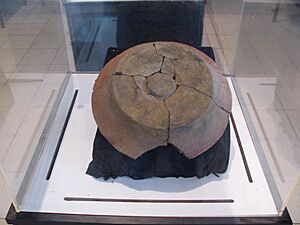
Lapita pottery is famous for its detailed, decorative designs. People made this pottery from different materials depending on what was available. They used various tools and techniques. Typically, the pottery was made from low-fired clay, mixed with shells or sand to make it stronger. They decorated it using a special tool that had teeth, like a comb, to stamp patterns onto the wet clay.
Some scientists think these designs might have come from other things, like patterns on bark cloth, mats, or even tattoos. Besides decorated pottery, the Lapita people also made plain pottery, including cups, cooking pots, and bowls. They also created tools and ornaments from shells, and stone tools like adzes (a type of axe) and flaked tools made from obsidian (volcanic glass) or other rocks.
How Did Lapita People Live?
Farming and Food
The Lapita people raised animals like pigs, dogs, and chickens. They were also skilled farmers. They grew root crops such as taro and yam, and tree crops like coconuts, bananas, and different kinds of breadfruit. They likely got more food by fishing and collecting shellfish from the ocean.
Trade and Travel
The Lapita people were great sailors and traders. They traveled long distances to exchange goods. They traded items like obsidian (which was used for sharp tools), adzes, and shells. This shows they had connections with many different islands.
What Were Lapita Burial Customs Like?
In 2003, archaeologists found a large cemetery at the Teouma site on Efate Island in Vanuatu. It had 25 graves with special burial jars and 36 human skeletons. All the skeletons were missing their heads! After the bodies were first buried, their skulls were removed and replaced with rings made from cone shells. The heads were then buried separately.
One grave had the skeleton of an older man with three skulls placed on his chest. Another grave contained a burial jar decorated with four birds looking into it. Scientists used carbon dating on shells from the site, which showed the cemetery was used around 1000 BCE.
Where Did Lapita People Settle?
Lapita villages in the area called Remote Oceania were usually built on beaches or small islands just offshore. They might have chosen these spots because inland areas, like in New Guinea, were already settled by other groups. Or, they might have wanted to avoid mosquitoes that carried malaria, as they likely didn't have protection against the disease. Some of their homes were even built on stilts over large lagoons.
However, in New Britain, some settlements were found inland, often near places where obsidian could be found. On the islands at the eastern end of the Lapita region, all settlements were inland, sometimes quite far from the coast.
Where Was the Lapita Culture Found?
The Lapita culture spread across a huge area, from Mussay to Samoa. Lapita pottery has been found in both Near Oceania and Remote Oceania. It reached as far west as the Bismarck Archipelago, as far east as Samoa, and as far south as New Caledonia.
For example, at a site in Mulifanua, Samoa, archaeologists found two adzes that looked very much like Lapita tools. Carbon dating suggests there was a Lapita settlement there around 1000 BCE. In New Caledonia, Lapita settlements might have existed as early as 1110 BCE. The exact locations and dates of more northern Lapita settlements are still being studied.
Scientists divide the Lapita culture into three main areas:
- Far Western Lapita: This includes the Bismarck Archipelago.
- Western Lapita: This covers the Solomon Islands to New Caledonia.
- Eastern Lapita: This includes the Fiji, Tonga, and Samoa regions.
Within the Eastern Lapita area, there are even more specific patterns, suggesting earlier and later styles.
What Language Did Lapita People Speak?
Linguists (people who study languages) believe that the Lapita people spoke an early form of what is now called Proto-Oceanic language. This language is a branch of the larger Austronesian languages family, which is spoken widely in Southeast Asia today. However, we don't know the exact language or languages the Lapita people spoke.
The languages spoken in the Pacific today come from many different ancient languages. Also, the tools and pottery found by archaeologists don't usually tell us what language people spoke. It's also likely that different Lapita groups in different islands had slightly different ways of speaking.
Some researchers, like Matthew Spriggs, believe that the Lapita people were the source of the Oceanic Austronesian languages and many cultural and religious ideas found across the Pacific.
Where Did the Lapita People Come From?
The Lapita culture is part of a huge movement of people called the Austronesian expansion. This expansion started from Taiwan about 5,000 to 6,000 years ago. Some of these travelers reached Melanesia. There are different ideas about the exact path they took. They might have gone through the Mariana Islands, or through the Philippines, or both.
A strong piece of evidence for the Lapita people being Austronesian comes from language studies. There are many similar words between Proto-Malayo-Polynesian (likely spoken in the Philippines) and Proto-Oceanic (likely spoken by the Lapita people). Also, these language similarities match patterns in the types of tools and pottery found.
In 2011, Peter Bellwood suggested that the first movement of Malayo-Polynesian speakers into Oceania was from the northern Philippines, eastward to the Marianas, and then southward to the Bismarcks. Another idea was that Lapita settlers first arrived in Melanesia through eastern Indonesia. Bellwood thought that both routes might have been used by different groups.
This idea is supported by pottery evidence: Lapita pottery looks more like pottery found in the Philippines (at the Nagsabaran site on Luzon Island) than pottery from anywhere else. This suggests that the Luzon area might have been where the special stamped pottery style of the Lapita culture began.
Archaeological findings also support the idea that the Lapita people came from Austronesian origins. About 3,500 years ago, the Lapita culture suddenly appeared in the Bismarck Archipelago as a fully developed culture with advanced tools. No evidence of earlier stages of development has been found there. This suggests that the Lapita culture was brought in by people who migrated, rather than developing locally.
Western Melanesia was already home to Papuans for 30,000 to 40,000 years. While some older tools were found, they were much less varied than the items from after the Lapita people arrived. The older culture seems to have only contributed a few things to the Lapita culture, like some crops and tools.
Most of the Lapita culture's items clearly came from Southeast Asia. These include their pottery, crops, paddy field farming, domesticated animals (chickens, dogs, and pigs), rectangular stilt houses, tattoo tools, and special boat technology. Lapita pottery gives the strongest proof of their Austronesian origin. It has very distinct features, like red coloring, tiny punch marks, stamped designs, and a cross-in-circle pattern. Similar pottery has been found in Taiwan, the Batanes and Luzon islands of the Philippines, and the Marianas.
Most experts today agree with the "Triple-I model" proposed by Roger Green and Peter Bellwood. This model says that the early Lapita culture came about in three steps:
- Intrusion: Austronesian people from Southeast Asian islands brought their language, tools, and ideas into Near Oceania.
- Innovation: Once in Melanesia, the Lapita people developed new technologies.
- Integration: The Lapita people mixed with the local (non-Austronesian) populations that were already there.
DNA Evidence
In 2016, scientists studied the DNA of four Lapita skeletons found in ancient cemeteries in Vanuatu and Tonga. The results showed that the Lapita people were descendants of people from Taiwan and the northern Philippines. This idea about their migration route was confirmed in 2020 by another study. This study compared the DNA of early settlers in the Mariana Islands with early Lapita people from Vanuatu and Tonga.
The results suggest that both groups came from the same ancient Austronesian population in the Philippines. The fact that there was no "Papuan" DNA mixed in these remains suggests that the travelers bypassed eastern Indonesia and most of New Guinea. The study also suggested that early Lapita Austronesians might have been direct descendants of the first people to settle the Marianas, who arrived about 150 years before them. This idea also fits with what we know from their pottery.
More recent DNA studies show that the Lapita people and modern Polynesians share ancestors with the Atayal people of Taiwan and the Kankanaey people of the northern Philippines.
How Was the Lapita Culture Discovered?
The first recorded discovery of Lapita items was made by Otto Meyer, a missionary, on Watom Island in 1909. A tropical storm hit the island and uncovered some pottery pieces. Meyer sent these decorated pieces to a museum in Paris.
In 1920, anthropologist William C. McKern found over 1500 pottery pieces on the island of Tongatapu, many with stamped designs. McKern didn't know about Meyer's discoveries and thought these pieces were prehistoric Fijian pottery. The connection between Meyer's and McKern's finds was made in 1940 when similar pottery was discovered on the Ile des Pins.
In the 1950s, Edward Winslow Gifford, who had worked with McKern, led expeditions that focused on the Koné Peninsula beach, where the name Lapita was created. Gifford used a new method called carbon dating on charcoal he found. This showed the artifacts were between 2,800 and 2,450 years ago. Gifford later showed how all these different discoveries were connected. He also proved a link between his Lapita artifacts and those found by Pieter Vincent van Stein Callenfels in Sulawesi.
In the 1960s, Jack Golson further confirmed the timeline of the Lapita model. He showed that the Lapita culture existed before the Melanesian and other Western Polynesian cultures.
Some important archaeological sites include Lolokoka in Niuatoputapu, Nenumbo in the Reef Islands (which shows the spread to the Solomon Islands), and Talepakemalai in Massau, which has some of the earliest Lapita findings in the Bismarck archipelago.
Lapita in Polynesia
As archaeologists learned more in the 1980s and 1990s, they realized that the Lapita people were the first settlers in parts of Melanesia and Western Polynesia. Many scientists believe that finding Lapita pottery in Melanesia proves that the ancestors of Polynesians passed through this area on their way to the central Pacific. The oldest archaeological site in Polynesia is in Tonga.
Other early Lapita sites in Tonga, dating back to 900 BCE, also contain the typical pottery and other tools found at Lapita sites in Fiji and eastern Melanesia from that time.
Anita Smith compared the Lapita period in Polynesia with a later period called the Polynesian Plainware ceramic period. She noted that there wasn't much change, except that a small part of the material culture disappeared. Most things stayed the same, similar to what happened after the Lapita period in Fiji and island Melanesia.
Plainware pottery is found on many Western Polynesian islands. It marks a time when Lapita pottery was no longer made, but before Western Polynesians stopped making pottery altogether. Archaeological evidence shows that plainware pottery stopped being made suddenly in Samoa around 1 CE.
According to Smith, "Pottery was not made by Polynesian societies at any time in East Polynesian prehistory."
Matthew Spriggs also said that the idea of a continuous culture between Lapita potters and Melanesians hasn't been explored enough. He noted that in most sites, the pottery styles overlapped, and there was no clear break. He found continuity in the type of clay used, the import of obsidian, and in non-ceramic tools.
See also
- Teouma – a major archaeological site in Vanuatu
- Archaeology in Samoa
- Early history of Tonga
Images for kids
-
Jack Golson at an excavation site in Vailele with a Samoan family, 1957.
-
Map showing the spread of Austronesian peoples across the Indo-Pacific over time.


